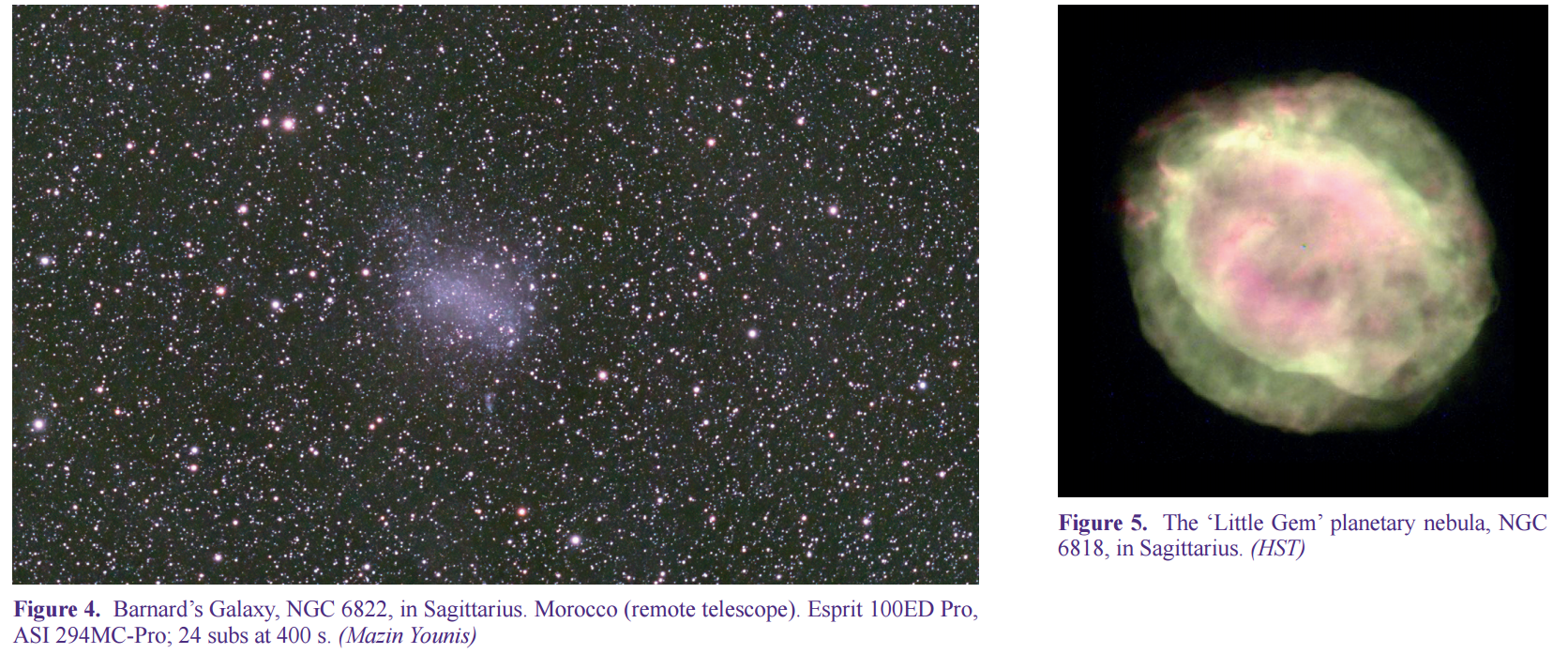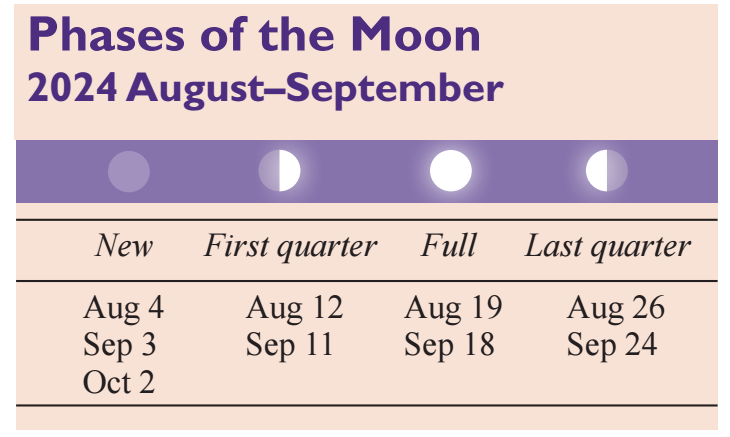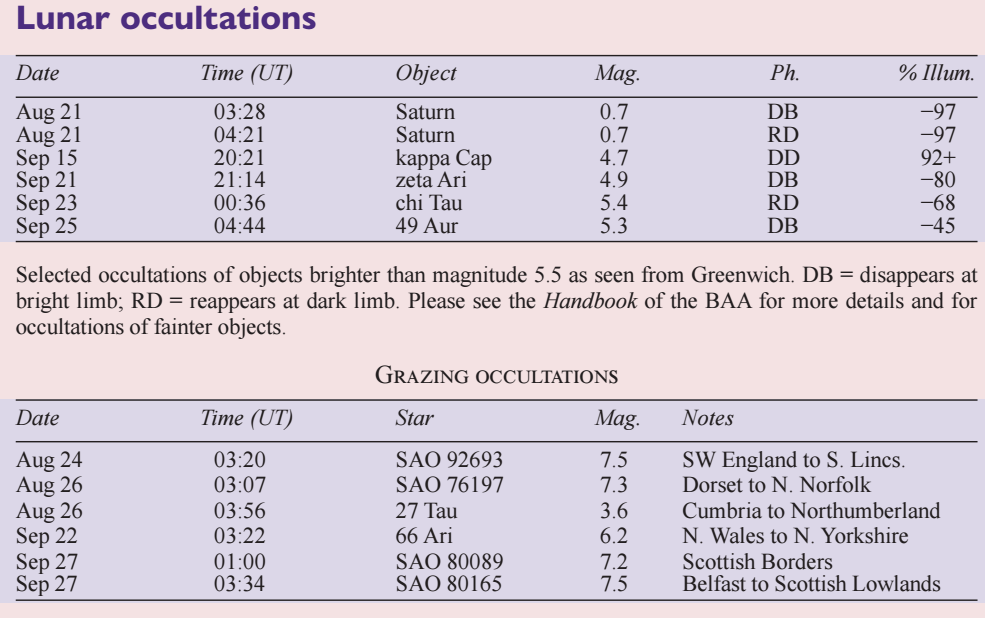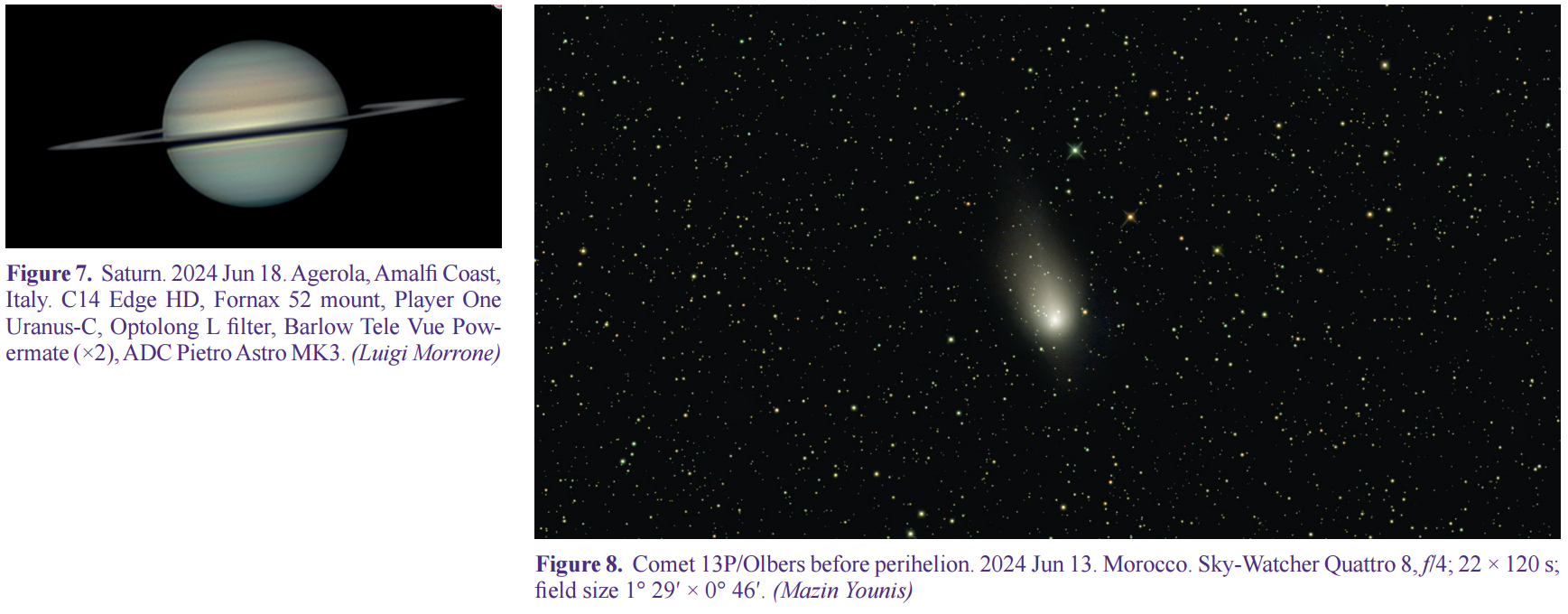Sky notes for 2024 August & September
2024 August 1

At last, we have darker nights and a planet to enjoy in the evenings! August through October can be the most comfortable and rewarding period of the observing year, with warm evenings and a reasonable window for a lengthy session at the telescope.
The deep sky
By the end of August, the Summer Triangle is high with Vega (alpha Lyrae) near the zenith, Altair (alpha Aquilae) approaching the meridian and Deneb (alpha Cygni) prominent in the glorious Milky Way of summer. On the southern meridian in the same month, Sagittarius scrapes the horizon and – sad to say – not all the four-legged archer appears in UK skies. What is visible is rich, as the centre of our galaxy lies in this direction with its unparallelled array of open and globular star clusters, bright and dark nebulae, plus variables and double stars aplenty. Anyone travelling or living in southern Europe can see the archer in his full glory, and even a DSLR camera mounted on a simple drive can capture super images. Those based in the UK will need to content themselves with the more northerly treats in the constellation. The so-called ‘Teapot’ asterism does not leap out of the southern horizon, but from its ‘spout’ emanates a dazzling steam of goodies.

In early September, one of the best globular star clusters is on the meridian mid-evening and is high enough to be found if a southern view allows. Messier 22 (M22, the Great Sagittarius Cluster; see Figure 1) culminates 15 degrees above the horizon and allows the observer to get their eye in before tackling fainter quarry. At magnitude 5.2, it is easy in a finder (or binoculars) and at 32 arcmin it is large, being similar to the full Moon in diameter. Nearby, to the southwest of M22, is M28, next to Kaus Borealis (lambda Sagittarii) – the star that represents the eye of the Archer, or if you prefer, the top of the Teapot’s lid! M28 is nearly two magnitudes fainter than M22, and a third of its size (11 arcmin). Directly west of M28 lies the spectacular Lagoon Nebula (M8; Figures 2 & 3), a large cluster with prominent emission spreading over a degree. To the Lagoon’s northwest lies the Trifid (M20), a very pretty nebula of contrasting colours when imaged, being a mixture of emission (pink) and reflection (blue) nebulosity divided into pleasing portions by denser, darker material.

Travelling north with the Teapot’s steam stream, we pass open cluster M21 then between M25 and M23 and through M24, the Small Sagittarius Star Cloud, to M18. We reach the northern tip of Sagittarius at M17, the Omega or Swan Nebula. A short sweep north finds the Eagle Nebula, M16, in Serpens Cauda (see image at top of p.301).

Serpens Cauda occupies an area to the east of Ophiuchus, rising in uneven steps from southwest to northeast. Its ascent begins with Scutum, then Aquila, located to its east. The pattern represents the eastern half of the somewhat inconvenienced serpent and dips into the Milky Way. At its furthest point northeast lies 4th-magnitude Alya, or theta Serpentis, an attractive, wide double star for the smallest of telescopes. The components are 22 arcsec apart and seem fixed. They are both A-type stars and generally regarded as white but shades of yellow have been mentioned.
Undoubtedly, the most spectacular sight in Serpens Cauda is the magnificent M16, the Eagle Nebula, which shot to fame as the ‘Pillars of Creation’ image from the Hubble Space Telescope (HST) in 1995. It was discovered by de Cheseaux in 1746 as an open star cluster, which of course it is, but then in 1764, Messier described faint nebulosity. Later, great observers such as Admiral Smyth, John Herschel, and T. W. Webb made no mention of this but regarded the cluster itself as ‘fine’. The early photographic era proved Messier correct, with Isaac Roberts, J. C. Duncan and E. E. Barnard recording it. More recently, it is this dramatic nebulosity that has achieved most fame and interest, especially to narrowband imagers. The contrast of bright emission with dark, silhouetted molecular clouds creates awe-inspiring patterns that have led to numerous interpretations such as a ‘Star Queen’ or a swooping bird of prey.

To the northeastern tip of the constellation, at a declination of 14 degrees south, lie a contrasting pair of deep-sky challenges. Firstly, try for an object that acts as a forerunner to the more famous members (Andromeda and Triangulum) of our Local Group of galaxies. Barnard’s Galaxy (NGC 6822; Figure 4) is a dwarf irregular galaxy located directly west of alpha and beta Capriconi. Its position on the eastern edge of the Milky Way should make it awkward to locate, but Barnard nabbed it with the 5-in Byrne refractor at Vanderbilt University Observatory back in 1884, before its nature was known. Hubble found several Cepheids within the galaxy and it is now known to be 1.6 million light-years from us, making it the closest galaxy that is not a satellite of the Milky Way. It is of interest that Hubble found the 15-arcmin galaxy ‘fairly conspicuous’ in the 4-in finder on the 100-in Hooker compared with the giant reflector itself. This low surface brightness should be straightforward with typical amateur telescopes from a dark site when low power is used. Its photographic image is reminiscent of the Small Magellanic Cloud.
Just half a degree northeast of Barnard’s Galaxy sits a tiny planetary nebula (PN), NGC 6818, nicknamed the Little Gem (Figure 5). It is fairly bright at 10th magnitude but just 15 arcsec in diameter. It is compact with a faint outer haze and slightly blue at high power with large apertures.

If Sagittarius and Serpens Cauda remain elusively low in your south, there is much to enjoy further north. Passing the striking Scutum Star Cloud and M11, the Wild Duck Cluster, enter Aquila to the east of the prominent Great Rift in the Milky Way, best appreciated from a dark site. Exploring the small planetary nebulae (PNe; Figure 6) that decorate the constellation like Christmas baubles is fun, but most are a challenge due to their small size. NGC 6803 and 6804 lie just west of Altair, with the latter being by far the easier. NGC 6803 is tiny but so close to NGC 6804 it should be identifiable using an O iii filter. Try for tiddlers NGC 6790 and NGC 6807 by all means, but end with arguably the best of the batch, NGC 6781. (See Table 1 on p.303 for more details.)
Finally, eta Aquilae is an excellent variable on which to hone your skills. It is a Cepheid variable, with only delta Cephei and low-amplitude Polaris being brighter. Its variability is more precise than clockwork, with a period of 7.17644 days and a magnitude range of 3.43–4.3. This pulsating supergiant was discovered back in 1784 by Edward Piggott and lies in the middle of the Eagle’s eastern wing. It can be compared with beta Aquilae (Alschain, of magnitude 3.7) which lies just below Altair. With practice, and clear skies, the cycle can be followed over a week with the naked eye alone.
The solar system

Moon & Sun
The partial lunar eclipse on Sep 18 is visible from the UK. For most of the event the Moon only enters Earth’s penumbral shadow, except for a small percentage clipping the umbra at maximum eclipse, which occurs around 02:44 UT.
The active Sun has given rise to much excitement already in 2024, with enormous sunspot groups and coronal mass ejections.The event in May generated spectacular aurorae the like of which few in England and Wales can remember (see p.238).
There is an annular solar eclipse on Oct 2. It lasts 7m 25s at maximum, but sadly nothing of it will be visible from the UK. The greatest eclipse is visible from the south Pacific, but it ends after crossing southern Chile and Argentina. However, it does pass over Easter Island, where intrepid travellers can enjoy over 6 minutes of the ‘Ring of Fire’ in a most atmospheric location.

Planets
Mercury is at inferior conjunction on Aug 19 and emerges into the morning sky to put on its best show of the year in early September. It is at greatest western elongation on Sep 5, before disappearing behind the Sun at the end of the month.
Venus is extremely low in the evenings during late summer – a poor apparition.
Now in Taurus, Mars remains a morning planet and its disc is becoming more manageable as it swells from 5.8 to 7.6 arcsec during August and September. In the past, 7 arcsec was regarded as the beginning of the observing season for Mars, but nowadays experienced imagers obtain remarkable detail when it is smaller.
Jupiter is also in Taurus, still a morning planet but getting quite high by the end of September. A close encounter with Mars can be observed on the mornings of Aug 14 & 15, when these contrasting worlds will be less than half a degree apart.

At last, we have a well-placed planet at a civilised hour as Saturn (Figure 7) reaches opposition on Sep 8. Its rings are markedly narrowed, and it is a good time to explore the family of moons that mainly lie in the ring plane. As a bonus, we can enjoy an occultation by the Moon on Aug 21 (see occultation table, p.303).
Uranus remains a morning planet in Taurus. It displays a small, green, 3.8-arcsec disc of magnitude 5.6 but will be better placed in late autumn.
Neptune lies a degree and a half northwest of 29 Piscium and has its opposition on Sep 21. Its tiny, 2.8-arcsec disc is magnitude 7.8 but its blue-green tinge should make it identifiable in small telescopes.
Meteors
The Perseids peak on the night of Aug 12/13. This reliable and popular shower will be favourable as the Moon – at first quarter – sets before it gets underway.
Many meteors can be seen either side of the peak of course, as the shower’s duration extends from mid-July until late August. Associated with Comet 109P/Swift–Tuttle, the Perseids have been known for two millennia and are sometimes dubbed the ‘Tears of St. Lawrence’. While not the richest shower, its timing in the balmy August nights makes it a favourite.
The Kappa Cygnids are much less rich, and they will be affected by the Moon this year. They peak on Aug 17, when the Moon is two days from full. The shower is often absent, but there are occasional bright fireballs so watch for anything brilliant arising from near Vega. The parent body remains unknown.
The Alpha Aurigids are at their maximum around Aug 31 when the Moon is absent. It is rather an anticlimax after the Perseids, being a much weaker shower, although occasional outbursts have been recorded. The meteors derive from comet C/1911 N1 Kiess.
Comets
There has been much speculation regarding the performance of C/2023 A3 Tsuchinshan–ATLAS after its perihelion on Sep 28. Will it survive? We shall have to hope so, as it could be a fine sight in October (see p.245).
The other comet that is worthy of attention through late summer is 13P/Olbers (Figure 8). This periodic object tracks eastward from southern Ursa Major and into Coma Berenices in late August. It avoids a Black Eye by passing half a degree north of M64 on Aug 24 & 25. It skids past the contrasting pair of globular clusters M53 and NGC 5053 on Aug 30 but will be fading rapidly as it pulls away from us, having passed perihelion on Jun 30. It will not be seen again for 69 years.
https://britastro.org/wp-content/uploads/2024/08/banner.jpg
https://britastro.org/wp-content/uploads/2024/08/fig1.png
https://britastro.org/wp-content/uploads/2024/08/fig2.png
https://britastro.org/wp-content/uploads/2024/08/fig3.png
https://britastro.org/wp-content/uploads/2024/08/fig4and5.png
https://britastro.org/wp-content/uploads/2024/08/fig6.png
https://britastro.org/wp-content/uploads/2024/08/fig7andFig8.png
https://britastro.org/wp-content/uploads/2024/08/occultations.png
https://britastro.org/wp-content/uploads/2024/08/phases.png
| The British Astronomical Association supports amateur astronomers around the UK and the rest of the world. Find out more about the BAA or join us. |
